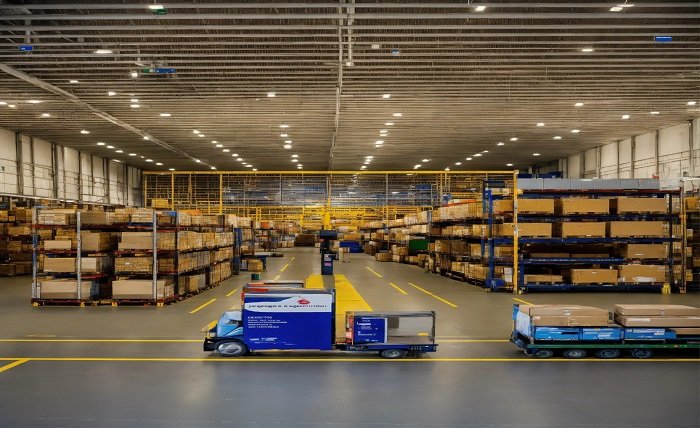UPS Distribution center: When it comes to package and commodity logistics and supply chain management, UPS distribution centres are essential. These centres, which form the core of UPS’s operations, ensure the effective sorting, handling, and delivery of packages to their intended locations. We will examine the features, advantages, and day-to-day operations of UPS distribution centres in this extensive guide. Gaining knowledge of these centres might help you better understand how UPS runs its vast network and upholds its reputation for dependable service. post-officehours
What is a UPS distribution centre?

A UPS distribution center is a facility that sorts and distributes packages within the UPS network. We position these facilities to minimise transit delays and optimise package flow. Serving as a hub for the reception, sorting, and subsequent delivery of goods is the main duty of a UPS distribution centre. This sorting procedure is necessary to handle millions of packages efficiently each day.
UPS Distribution Centres’ Function in Logistics
The UPS distribution centet plays a crucial role in the supply chain. They facilitate process optimization by effectively managing large volumes of packages. A UPS distribution centre sorts packages according to where they are going as they arrive. This sorting helps to shorten delivery times and minimise delays by sending items via the most effective routes. Additionally, UPS distribution centres oversee inventory and ensure proper package handling to reduce the risk of errors or losses.
UPS Distribution Centers Enhance Delivery Efficiency
One of the main benefits of UPS distribution centres is their ability to increase delivery efficiency. UPS can expedite package sorting and shipping by gathering packages at strategic locations. This centralisation enables faster package processing and more precise tracking. UPS distribution centres employ cutting-edge technology, like automated sorting systems, to efficiently and precisely handle massive volumes of parcels. This efficiency leads to shorter delivery times and greater client satisfaction.
UPS Distribution Centre Types
Within the logistics network, UPS has a variety of distribution centres, each with a distinct function. Among them are:
Hub distribution centres are sizable: establishments that manage large amounts of parcels and act as hubs for routing and sorting.
Regional Distribution Centres: These hubs oversee packages in certain areas, enabling effective local delivery.
Service centres are smaller: establishments that specialise in customer service or package management for particular areas.
Every kind of UPS distribution centre is essential to making sure that goods arrive on schedule and undamaged.
The UPS Distribution Centres’ Technology
UPS distribution centres install modern technology to maximise efficiency. Conveyor belts, sophisticated tracking software, and automated sorting methods are essential to these centres’ smooth operation. The system automatically sorts parcels based on their size, weight, and destination, while the tracking software provides real-time updates on their status. Thanks to this technology, packages will travel rapidly through the system and get to their destinations as soon as possible.
UPS Distribution Centre Advantages
UPS distribution centres offer a variety of benefits, including
Enhanced Efficiency: By optimising sorting and routing procedures, we achieve more precise delivery and shorter transit times.
Cost Savings: By streamlining operations and maximising resource use, centralised processing reduces expenses.
Better Tracking: Thanks to technological advancements, customers can now track packages in real-time and receive the most recent details on their shipments.
These advantages help UPS maintain its capacity to offer dependable and prompt delivery services.
The impact of UPS distribution centres on international trade is significant
UPS distribution centres facilitate the transfer of goods across borders, which plays a vital role in global trade. UPS distribution centres facilitate the efficient processing and shipping of overseas shipments, thereby supporting international supply chains. UPS distribution centres are ideally situated to facilitate the seamless movement of commodities from producers to customers across the globe. This effect is especially noticeable in sectors like manufacturing and e-commerce, where prompt product delivery is essential.
Obstacles UPS Distribution Centres Face
UPS distribution centres have numerous benefits, but they also have certain drawbacks. Among them are:
Capacity management: Processing a lot of packages at once might put a strain on infrastructure and resources.
Technology Integration: To keep up with the rapidly changing world of technology, constant investment and adaptation are required.
Operational Efficiency: To maintain service quality, you must ensure error-free operations and minimise disruptions.
Resolving these issues is essential to preserving UPS distribution centres’ efficiency and dependability.
UPS Distribution Centre Future Trends
We anticipate that several trends will impact UPS distribution centres in the future, including:
Enhanced Automation: Developments in robotics and automation technologies will further improve sorting and processing capacities.
Sustainability Initiatives: UPS focuses on using eco-friendly procedures and technologies to reduce its environmental impact.
Enhanced Data Analytics: This technology can provide better insights into package flow and operational effectiveness.
These factors will influence the evolution of UPS distribution centres and their place in the logistics network.
Find a UPS Distribution Center
It’s not too difficult to locate a UPS distribution centre nearby. On its website, UPS offers a location finder feature that lets consumers look up distribution centres by entering their address or zip code. You can also obtain information about the services offered by the closest distribution centre by contacting UPS customer support.
In summary
UPS distribution centres guarantee the effective processing and delivery of goods, making them vital parts of the worldwide logistics network. They play a crucial role in the supply chain because of their ability to facilitate international trade, improve delivery efficiency, and use cutting-edge technology. UPS’s distribution centres will continue to be at the forefront of its operations, driving gains in efficiency and service as it innovates and adjusts to changing market demands. technewztop
FAQ
What is a UPS distribution centre’s primary purpose? A UPS distribution centre’s primary responsibility is to effectively sort and distribute packages throughout the UPS network so they arrive at their destinations on time.
What is how a UPS distribution centre expedites delivery? UPS distribution centres use cutting-edge technology to process goods quickly and precisely, centralizing the sorting and routing of shipments to improve delivery times.
What kinds of UPS distribution center facilities exist? UPS distribution centres come in a variety of forms, each fulfilling a distinct role in the logistics network. These include hub distribution centres, regional distribution centres, and service centres.
Which technologies do UPS distribution centres use? Conveyor belts, automated sorting systems, and real-time tracking software are examples of technology used by UPS distribution centres to streamline processes and boost productivity.
How can I locate a local UPS distribution center? Using the UPS website’s location finder tool or getting help from UPS customer support, you may be able to locate a UPS distribution centre in your area.

